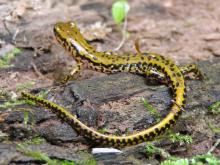Reptiles and Amphibians
Media

Species Types
Scientific Name
Plethodon albagula
Description
The western slimy salamander is a black to blue-black salamander irregularly marked with silvery flecks. It occurs in the Ozark Highlands and the Lincoln Hills north of the Missouri River. True to its name, it secretes a thick substance that sticks to skin like glue.
Media

Species Types
Scientific Name
Eurycea lucifuga
Description
The cave salamander is a common amphibian of the Ozark Plateau. It lives in caves, springs, and rocky streams. Recognize it by its normally bright orange skin dotted with dark brown or black spots.
Media

Species Types
Scientific Name
Siren intermedia nettingi
Description
The western lesser siren is an eel-like, aquatic salamander with external gills, small eyes, small forelimbs with four toes, and no hind limbs. In Missouri, it’s found mostly in the Bootheel and northward in counties near the Mississippi River.
Media

Species Types
Scientific Name
Eurycea longicauda longicauda (eastern dark-sided salamander) and E. l. melanopleura (dark-sided salamander)
Description
The eastern long-tailed salamander and closely related dark-sided salamander are agile and can escape predators by using their tails for quick jumps. They live in the southern and eastern parts of Missouri.
Media

Species Types
Scientific Name
Necturus maculosus maculosus
Description
Mudpuppies are aquatic salamanders that have plumelike external gills throughout their entire lives. They’re found in the southern half and along the eastern edge of Missouri.
See Also
About Reptiles and Amphibians in Missouri
Missouri’s herptiles comprise 43 amphibians and 75 reptiles. Amphibians, including salamanders, toads, and frogs, are vertebrate animals that spend at least part of their life cycle in water. They usually have moist skin, lack scales or claws, and are ectothermal (cold-blooded), so they do not produce their own body heat the way birds and mammals do. Reptiles, including turtles, lizards, and snakes, are also vertebrates, and most are ectothermal, but unlike amphibians, reptiles have dry skin with scales, the ones with legs have claws, and they do not have to live part of their lives in water.





















